Nature: Collarwali : A Majestic Symbol of Wildlife Preservation

A saga of the tigress who came to be known as the Queen of Pench and was the inspiration behind a myriad of business and conservation initiatives.
As the majestic tigress arched towards the water hole, head down, her little ones mimicked her, sipping carefully from the edge of the bank. Four beautiful bodies, elegant beyond any he knew, limbs glistening, stripes unmissable. Photographer Sarosh Lodhi captured what would become an iconic photograph of three cubs and their mother Collarwali, one of India’s most celebrated tigresses—one who generated a surge of ripples that spread far and wide, indirectly feeding neighborhoods, sustaining employment, orchestrating public policies, and boosting wildlife conservation.
A legend was born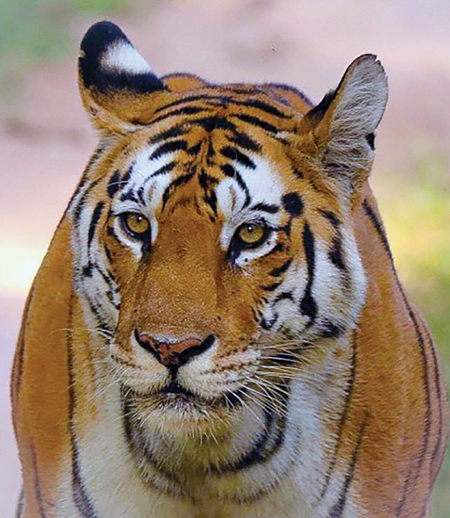
The story flashes back to 2005, to Pench Tiger Reserve (PTR), a setting Rudyard Kipling had supposedly used for his famous The Jungle Book. Here, in the clammy forest of Seoni district of Madhya Pradesh, Collarwali was born as T15 to popular parents, mother Badi Mada (T7) and father Charger (T1). At that time, PTR reportedly had a population of around 15 adult tigers.
[Right] Collarwali earned the titles of “Supermom” and “Queen of Pench.” (Photo: Omveer Choudhary)
“When we used to go to that area in the mid-’80s as teenagers, it was not called PTR,” recalls Sanjay Narla, an Atlanta resident who spent his childhood days around 30 miles from the reserve. “There were hardly any tigers then.” Today, that number has quadrupled, thanks largely to Collarwali, a prolific breeder who reared eight litters from which 25 cubs survived, a feat that earned her titles of “Supermom” and “Queen of Pench.”
Taking advantage of PTR’s strategic location, some of Collarwali’s progeny were even transferred to nearby Satpura and Panna Reserves to restore local tiger populations. Situated in the heart of India, PTR is now an important corridor of tiger movement across the nation.
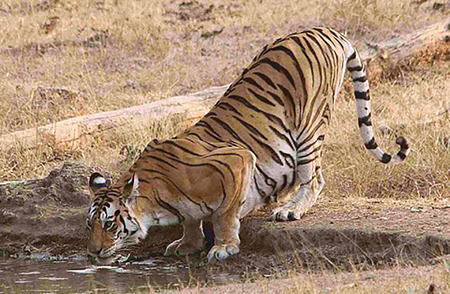
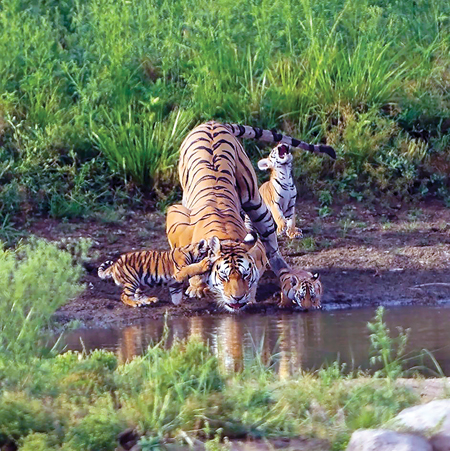 The Queen’s popularity didn’t come just from the distinctive radio collar around her neck (for tracking and research) or from having mothered a record number of cubs; it stemmed from qualities that tigers don’t usually display: sashaying around in the open without aggression, unafraid of camera-toting tourists in jeeps or officials surveying the wild on elephant backs.
The Queen’s popularity didn’t come just from the distinctive radio collar around her neck (for tracking and research) or from having mothered a record number of cubs; it stemmed from qualities that tigers don’t usually display: sashaying around in the open without aggression, unafraid of camera-toting tourists in jeeps or officials surveying the wild on elephant backs.
[Left] It was her fierce motherhood and size that set the majestic tigress apart. (Photo: Omveer Choudhary)
“Tigers are inherently evasive and shy,” says Dr. Akhilesh Mishra, a Pench veterinarian who had been tracking Queen since her birth. “But not Collarwali. She got so used to people and was so smart that she would use our elephants to ambush her prey.” After having lived around wild tigers for decades, Mishra has learned to recognize their smallest gestures, and calls it “understanding the significance of the insignificant incidents.”
[Right] “Supermom” was a prolific breeder who reared eight litters from which 25 cubs survived. (Photo: Sarosh Lodhi)
Mishra infers that Collarwali’s early exposure to elephants and people squashed her fear and built her trust. “When sick or injured, she would lie in the open as rescue teams approached her on elephants,” he reminisces, “and wait for us to dart her and offer medical care.” Over time, she had likely made the smart connection between humans on tuskers to the treatment of her wounds. “There were times when she needed her space, and would show her mood with a simple whip of her tail tip.”
Her atypical temperament ensured plenty of media coverage for Pench. When she was barely toddling as a cub, a BBC crew with trunk cameras captured her childhood journey for a TV series Spy in the Jungle narrated by Sir David Attenborough. Collarwali brought about a thriving economy and increased awareness that preserving tigers meant preserving mankind.
The mother to her 25 cubs
“We’ve seen several tigresses,” continues Mishra, “but not [just anyone] becomes Queen of Pench.” The passion in his voice is understandable, given the sixteen years of his close journey with the Queen. It was also Collarwali’s tenacity and size that set her apart. “Collarwali was big and was often mistaken for a male,” he gushes. “She was so strong and efficient that she could make two to three kills per day. Her cubs ate constantly like dinosaurs. So, she knew they had to be kept well-fed.”
The Supermom frequently traveled with her litter to a little island in her territory, where she conducted many training lessons. “Collarwali would bring down spotted deer and leave them alive so her cubs could complete the hunting process.” She used her size and motherly instincts to shield her offspring from other belligerent males. She ruled a prime territory at Pench till her last breath. Again, this was unusual, given the norm that aging big cats, especially females, lose their dominance to younger tigers or get wounded defending their cubs against other male tigers. “It was not just her big size,” offers Mishra. “What made her the Queen was that fierce motherhood.”
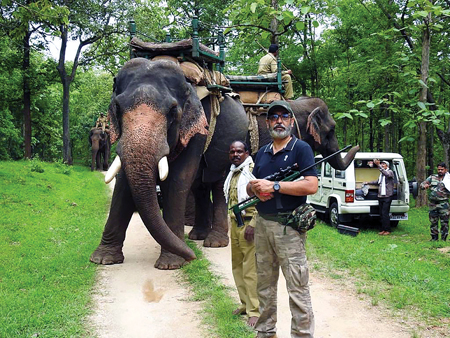
[Top] Dr. Akhilesh Mishra, a Pench veterinarian who had been tracking Collarwali since her birth.
What cast T15 as a beloved, much-sighted Supermom was not merely her genes, but a plethora of factors— many of which were well-planned and thoughtout, earning PTR the reputation of being one of the best-managed tiger reserves in the country, a standing bestowed by Wildlife Institute of India.
In 2002, PTR drew up an eco-development blueprint to involve the local community. “Ecotourism committees were set up in all 107 villages around the reserve,” said PTR Field Director Vikram Singh Parihar. “We share 33 percent of tourism income with these committees.” Also, the management coached cattle grazers and carried out a voluntary relocation of villages so that no human habitations remained in the core, protected areas. “We make sure tigers don’t step out of these areas into vulnerable habitats where they could face human backlash,” says Mishra, who is in charge of resolving such animal-human conflicts. “It’s important that locals are educated. It is they who should own the tiger, not the government.” The death of cattle often triggers negative responses from locals, and wildlife can be harmed by poaching or poisoning.
Another critical factor to countering this has been an abundance of prey—a hallmark of good reserve health—including chitals, sambhars, and wild boars. To maintain habitat diversity and enough swaths of grassland, invasive and poisonous species of fauna are regularly cleared. The PTR management maintains a coterie of vigilantes monitoring signs of possible animal electrocutions along supply lines, and an experienced elephant-mounted rescue team trained to promptly arrive at the problem spot, a job fraught with peril. “When I got off my elephant one day to check on a tranquilized tigress, a massive male emerged out of nowhere,” says Mishra who wisely ordered the mahout to get the elephant to lunge at a nearby tree. As the tree came crashing down, the male fled. The rescued tigress went on to mother two litters.
Not just good for the environment, but also for the local economy
The lack of human intrusions, an adequate food supply, and a favorable terrain offers a stress-free environment for the tigers in PTR, a place Collarwali thrived in, breeding copiously.
The message has not been lost on tiger conversationalists (and politicians) that protecting their wildlife, especially famed and usually elusive species, injects life and lucre not just into forest departments, but also the local populations, surrounding resorts, small businesses, and eventually state coffers. “Tigers bring prosperity,” notes Mishra. “It took time, but now everyone understands that. Personally, I believe protecting tigers means protecting grounds where the rivers flow—areas that are the lungs of the nation. On a big scale, protecting tigers is protecting the earth.”
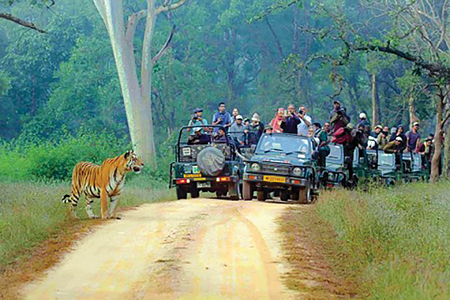
[Top] The Queen of Pench was a famed tourist attraction. (Photo: Omveer Choudhary)
Before Collarwali, there was Paarwali of Corbett Park, Sita and Charger of Bandhavgarh, Maya of Tadoba Andhari, and of course, Machli—the prima donna of Ranthambore—in whose honor the Rajasthan government issued a postage stamp. This was not without reason: when Machli went missing for more than three weeks, the world around the park deflated, resulting in a reported loss of Rs. 200 crores. When the tigress was eventually found, thousands celebrated.
In a controversial move, the park officials kept an aged Machli alive by feeding her live calves well beyond her days of stalk and strike. The economics are often so obvious and alluring, officials take protection of specific species to such an extent that they sometimes are in danger of losing sight of other wildlife.
During her last days, Collarwali grew sluggish. Something seemed to bother her. She tried what had worked for her in the past: lying in the open and waiting for the elephants to bring her veterinary care. But now, her time had arrived. She couldn’t overcome the intestinal blockages which proved too severe for her age. The Queen of Pench passed away on January 15, 2022.
The legend that Collarwali had become, she enriched human lives around her and symbolized the potential of nature conservation—something even the famed naturalist Sir David Attenborough would have never guessed when BBC filmed her as a defenseless cub wobbling and circling around her mother.
Ajay Vishwanathan is a widely published fiction author and a regular Khabar contributor who writes on current issues and events pertaining to music, artists, nature and more. He’s the founder and chief editor of Lucid Lines Academy.
Enjoyed reading Khabar magazine? Subscribe to Khabar and get a full digital copy of this Indian-American community magazine.
blog comments powered by Disqus










